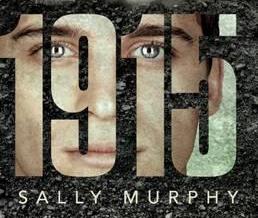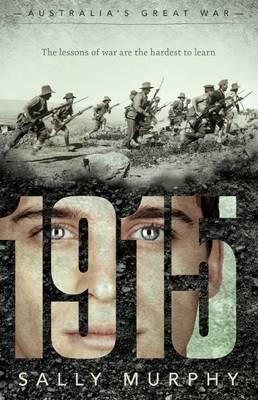How do you write historical fiction?
Meet writerly friend Sally Murphy, prolific children’s author of over thirty books. On the 100 year anniversary of Gallipoli and the ANZACs, Sally launched a powerful new historical fiction novel 1915 for children.
About the book 1915:
When Australia throws its support behind Britain in its fight against Germany, young teacher Stan Moore is one of the first to join up, swapping the classroom for adventure in Europe. But the 11th Battalion is sent with the newly formed Anzac Corp to Gallipoli, where Stan is confronted by the hard lessons of war. Though conditions are dismal and death is everywhere, so is the humour and bravery that is the true spirit of Anzac.
The silence was eerie. In the darkness I could just see the mist that swirled around the rowboat. No-one spoke, no-one made a sound. Somewhere ahead a loud report. A shot? Rifle fire, from the beach, which was only dimly coming into view. This was it.
I’m a resilience author teacher and a huge history buff too, dreaming of writing historical fiction for children one day myself. I interviewed Sally to get tips on how to write historical fiction.
How to Write Historical Fiction?
- Why did you choose teacher Stan Moore’s story of his recruitment in the Great War for the subject of 1915?
I was asked by Scholastic to write a fictional story set in 1915. When trying to think of a character with whom young readers would connect, I thought of a teacher. I read some really interesting articles and books about life on the home front, and the impact of the war on schools and this cemented my idea of having a teacher as the main character. When I tried to figure out how best to show the impact on the home front, I wondered who was teaching his class back home.
The idea that it could be his twin sister meant that not only could I connect Stan with his students but also show the impact on his family. Elizabeth, Stanley’s sister, writes him letters, telling him about the school and about the family, as well as news of the day and her worries for his safety. Stanley, in turn keeps in touch with Elizabeth and also his students.
- How is your story 1915 relevant to children in 2015?
The ANZAC legend born in 1915, and of course the centenary of these events is being celebrated this year. Reading a story set in the midst of the war gives students an understanding of what happened. Rather than just reading dates and figures, children can experience war first hand through the eyes of a character.
Reading stories about our past helps to shape our present and our future. I don’t want to glorify war; I want to show the human impact, in the hope that readers will see how terrible it is. Maybe one day we can have world peace!
- What lessons can children learn from 1915?
Hopefully they’ll see that even in the midst of terrible adversity, qualities like friendship and determination and even a sense of humour can still come to the fore. I’d also like them to see soldiers were just normal men – some of them very young – doing their best because they believed it was right. I hope children will see how tragic war is, and start thinking about ways to ensure a more peaceful future.
- What themes do you explore in 1915?
Obviously the theme of war is very strong, and the associated topic of courage, but also themes including friendship, family bonds and the value of humour. Another theme that crept in is the way that having a creative outlet can help in difficult times.
Stanley carries a notebook and writes poetry and his friend CJ draws at every opportunity. The creation of the ANZAC Book – a kind of annual that was put together in the last weeks of the Gallipoli campaign – is also featured, with Stanley having a role in collecting material.
Part of the Australia’s Great War series from Scholastic Australia, 1915 has been released in time to commemorate the 100 year anniversary of the landing of the first ANZACs at Gallipoli.
You can learn more about 1915 and about Sally Murphy at her website: www.sallymurphy.com.au or her Facebook page.
Related Blogs
Roses are Blue by Sally Murphy
How to Get Published by Sally Murphy
Were Sally’s tips on writing historical fiction helpful to you?
Does the positive messages from 1915 resonate with you?
Please comment, like, tweet and google +




This looks to be an exciting and intriguing book, set in a very important time in Australia s history. I can’t wait to read it
Hi Steve,
An exciting book Indeed! Love the fact that’s is written about a school teacher. Something kids and teachers will be able to relate to… Cheers, Karen 🙂
Very helpful. Thank you, Karen. 🙂
Hi Jacqui, I thought you’d be interested in Sally’s historical book and Tips … Karen 🙂
Many thanks, Sally and Karen. I very much look forward to reading this book. And what a fantastic cover design.
I’ve discovered so many fascinating and little known facts I’d love to include in the historical story I’m researching/writing, but there’s no room for them or they are not 100% relevant to the text. Did you find that, Sally? I guess they can always be provided on your website as an extra for readers.
Best wishes
Peter
I love writer interviews that make you walk away feeling like writing in that genre. Well done Sally and Karen. I love historical books that bring history alive for us in this way.
Thanks for doing this interview. I love this genre of writing, for bringing history into a form where we can absorb it more easily than in set text books. It makes it so real. I hope to write in this genre too, and have a book underway which I am working out how to write.
Hi June,
Thrilled you enjoyed the interview and were inspired by Sally’s historical fiction tips … Karen 🙂
Hi Peter,
Glad to hear about your own historical fiction book.
Thanks for asking that question about “Those little known facts.” Hope Sally comes over to answer your question soon … Karen 🙂
Thanks everyone for reading and commenting. Peter, yes, there are so many interesting facts about any time period. the trick is to not cram in so many that the story gets lost. Most facts should be included because they either build the plot or they build the sense of the place/time in which that plot is happening. If they are just there to ‘show off’ what I know, or simply to be a history lesson, readers will catch on and switch off. It is important with historical fiction that story is the focus.